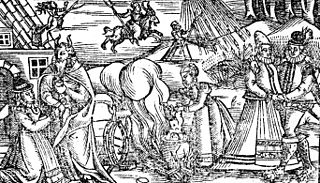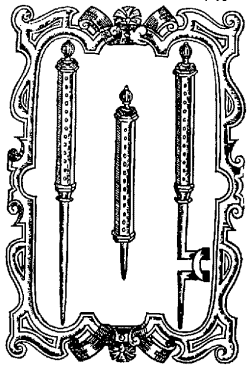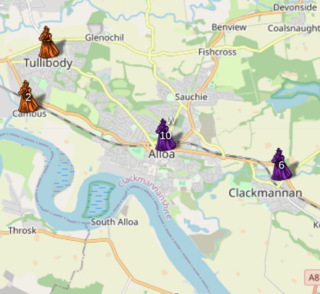Related Research Articles

Isobel Gowdie was a Scottish woman who confessed to witchcraft at Auldearn near Nairn during 1662. Scant information is available about her age or life and, although she was probably executed in line with the usual practice, it is uncertain whether this was the case or if she was allowed to return to the obscurity of her former life as a cottar’s wife. Her detailed testimony, apparently achieved without the use of violent torture, provides one of the most comprehensive insights into European witchcraft folklore at the end of the era of witch-hunts.

The Tolbooth in Aberdeen, Scotland is a 17th-century former jail which is now operated as a museum. The museum contains prison cells and exhibits various police and law and order related items. The building has been featured on popular television as the setting for a ghostlore story.
The Great Scottish Witch Hunt of 1597 was a series of nationwide witch trials that took place in the whole of Scotland from March to October 1597. At least 400 people were put on trial for witchcraft and various forms of diabolism during the witch hunt. The exact number of those executed is unknown, but is believed to be about 200. The Great Scottish Witch Hunt of 1597 was the second of five nationwide witch hunts in Scottish history, the others being The Great Scottish Witch Hunt of 1590–91, The Great Scottish Witch Hunt of 1628–1631, The Great Scottish witch hunt of 1649–50 and The Great Scottish Witch Hunt of 1661–62.

In early modern Scotland, in between the early 16th century and the mid-18th century, judicial proceedings concerned with the crimes of witchcraft took place as part of a series of witch trials in Early Modern Europe. In the late middle age there were a handful of prosecutions for harm done through witchcraft, but the passing of the Witchcraft Act 1563 made witchcraft, or consulting with witches, capital crimes. The first major issue of trials under the new act were the North Berwick witch trials, beginning in 1590, in which King James VI played a major part as "victim" and investigator. He became interested in witchcraft and published a defence of witch-hunting in the Daemonologie in 1597, but he appears to have become increasingly sceptical and eventually took steps to limit prosecutions.

The great Scottish witch hunt of 1649–50 was a series of witch trials in Scotland. It is one of five major hunts identified in early modern Scotland and it probably saw the most executions in a single year.
Geillis Duncan also spelled Gillis Duncan was a young maidservant in 16th century Scotland who was accused of being a witch. She was also the first recorded British named player of the mouth harp.
Margaret Bane also called Clerk, was a Scottish midwife and prominent victim of The Great Scottish Witch Hunt of 1597.

Witchcraft in Orkney possibly has its roots in the settlement of Norsemen on the archipelago from the eighth century onwards. Until the early modern period magical powers were accepted as part of the general lifestyle, but witch-hunts began on the mainland of Scotland in about 1550, and the Scottish Witchcraft Act of 1563 made witchcraft or consultation with witches a crime punishable by death. One of the first Orcadians tried and executed for witchcraft was Allison Balfour, in 1594. Balfour, her elderly husband and two young children, were subjected to severe torture for two days to elicit a confession from her.
Janet Wishart, was an accused witch from Aberdeen who became known as the Great Witch of Scotland. Wishart was an important figure in the great Scottish witchcraft panic of 1597 as her family were the focus of the trials in Aberdeen where 22 women and one man were found guilty of witchcraft.

The Pittenweem witches were five Scottish women accused of witchcraft in the small fishing village of Pittenweem in Fife on the east coast of Scotland in 1704. Another two women and a man were named as accomplices. Accusations made by a teenage boy, Patrick Morton, against a local woman, Beatrix Layng, led to the death in prison of Thomas Brown, and, in January 1705, the murder of Janet Cornfoot by a lynch mob in the village.

Margaret Aitken, known as the Great Witch of Balwearie, was an important figure in the great Scottish witchcraft panic of 1597 as her actions effectively led to an end of that series of witch trials. After being accused of witchcraft Aitken confessed but then identified hundreds of women as other witches to save her own life. She was exposed as a fraud a few months later and was burnt at the stake.

The Bute witches were six Scottish women accused of witchcraft and interrogated in the parish of Rothesay on Bute during the Great Scottish Witch Hunt of 1661–62. The Privy Council granted a Commission of Justiciary for a local trial to be held and four of the women – believed by historians to be Margaret McLevin, Margaret McWilliam, Janet Morrison and Isobell McNicoll – were executed in 1662; a fifth may have died while incarcerated. One woman, Jonet NcNicoll, escaped from prison before she could be executed but when she returned to the island in 1673 the sentence was implemented.
Marie Lamont, also referred to as Mary Lawmont (1646–1662), was executed for witchcraft during the reign of Charles II just after Witchmania had peaked in the United Kingdom. Her youth at the time of her execution made her case unusual.
Bessie Wright was a healer in Perthshire who was accused of witchcraft in 1611, 1626 and then again in 1628.
Alison Pearson was executed for witchcraft. On being tried in 1588, she confessed to visions of a fairy court.
Violet Mar was a Scottish woman accused of plotting the death of Regent Morton by witchcraft.
Witches of Scotland was a campaign for legal pardons and historic justice for the people, primarily women, convicted of witchcraft and executed in Scotland between 1563 and 1736. A pardon and an apology was made on 8 March 2022. The aim was also to establish a national memorial for the convicted from the Scottish parliament.

Margaret Duchill was a Scottish woman who confessed to witchcraft at Alloa during the year 1658. She was implicated by others and she named other women. She was executed on 1 June 1658.
Anna Tait or Anne Tait, also known as 'Hononni', was accused of witchcraft in Haddington, East Lothian in 1634 and executed in 1635. Her case revolved around her feelings of grief and guilt which caused her suicidal thoughts for the murder of her first husband and the death of her beloved daughter following a botched home abortion.
References
- ↑ Archibald, Megan Bellatrix (2021-03-31). "Witch Trials In Aberdeen – Megan Bellatrix Archibald" . Retrieved 2023-09-10.
- ↑ Saunderson, Jamie (2022-03-02). "Remembering the horror of Aberdeen's infamous 16th century witch hunts". aberdeenlive. Retrieved 2023-09-10.
- ↑ Goodare, Julian (May 2001). "The Aberdeenshire Witchcraft Panic of 1597". Northern Scotland. 21 (1): 17–37. doi:10.3366/nor.2001.0003. ISSN 0306-5278.
- 1 2 3 "Witches". Doric Columns. 2017-11-18. Retrieved 2023-09-10.
- 1 2 3 4 5 6 7 8 Metcalfepublished, Tom (2016-07-19). "'Witch' Prison Revealed in 15th-Century Scottish Chapel". livescience.com. Retrieved 2023-09-10.
- 1 2 3 4 5 6 7 8 "Aberdeenshire Witch Hunt Executions Brought to Light | News | The University of Aberdeen". www.abdn.ac.uk. Retrieved 2023-09-10.